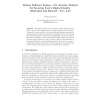5843 search results - page 7 / 1169 » Software Security in Practice |
ACSAC
2010
IEEE
13 years 5 months ago
2010
IEEE
Instruction-set randomization (ISR) is a technique based on randomizing the "language" understood by a system to protect it from code-injection attacks. Such attacks wer...
CCS
2010
ACM
13 years 4 months ago
2010
ACM
Cryptographic systems and protocols are the core of many Internet security procedures (such as SSL, SSH, IPSEC, DNSSEC, secure mail, etc.). At the heart of all cryptographic funct...
SOUPS
2010
ACM
13 years 11 months ago
2010
ACM
The principle of least privilege requires that users and their programs be granted the most restrictive set of privileges possible to perform required tasks in order to limit the ...
FOSSACS
2006
Springer
13 years 11 months ago
2006
Springer
Abstract. Web services are an important series of industry standards for adding semantics to web-based and XML-based communication, in particular among enterprises. Like the entire...
ACISP
2003
Springer
14 years 26 days ago
2003
Springer
Abstract. This paper presents a robust software token that was developed to protect user’s digital identity by simple software-only techniques. This work is closely related to Ho...

